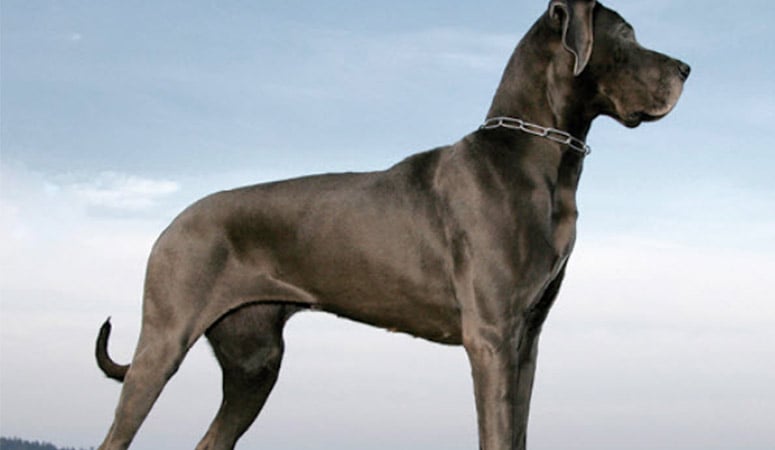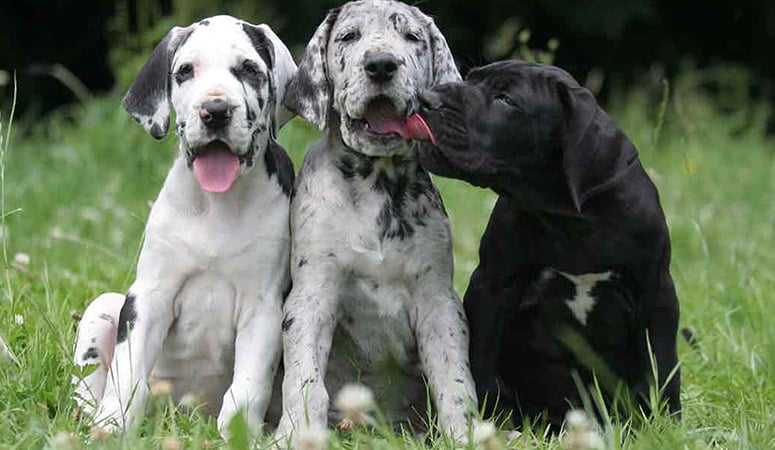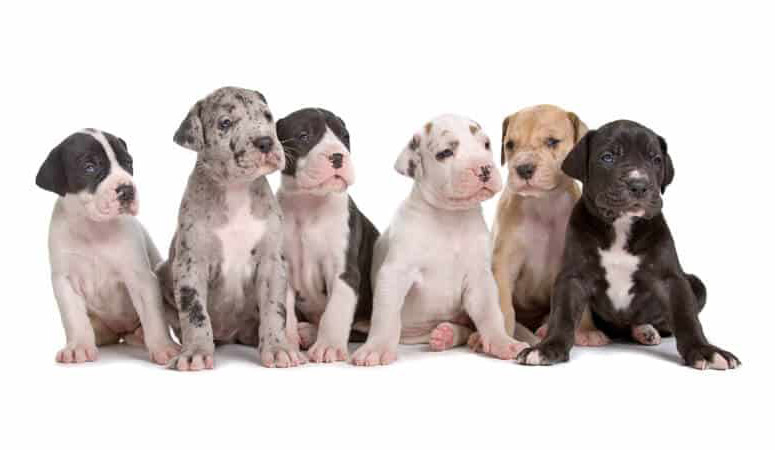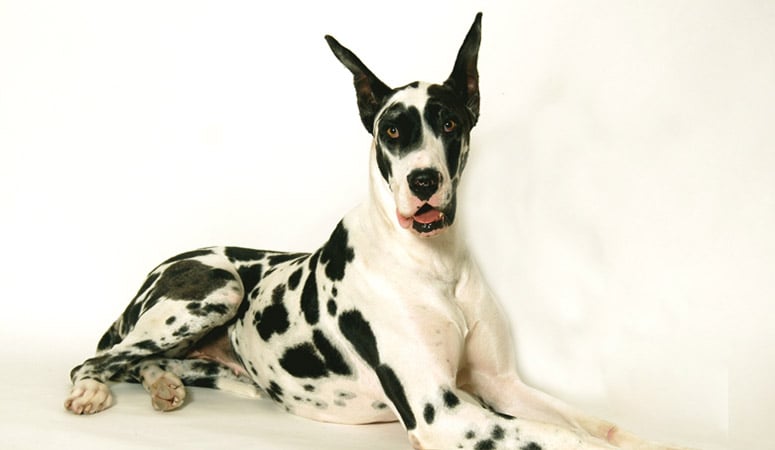Great Dane
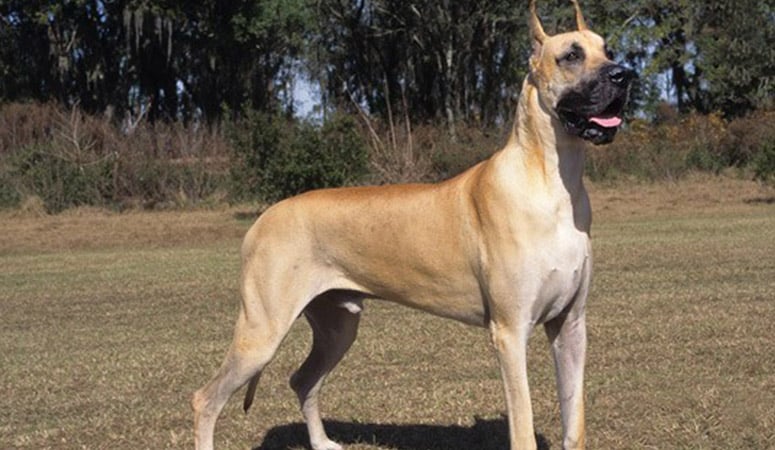
The Great Dane has a large body and heart and combines great size and power with elegance, earned the name of “Apollo of Dogs”. They have a strong and powerful gait and easy strides, and their coat is short, thick and glossy. The Great Danes were bred for hunting and guarding the German nobles, and now they are bred as beloved companions, family guardians and service dogs.
| Other Names | Deutsche Dogge, German Mastiff |
| Color | White, black, blue, brindle, merle, fawn, and black and white (including mantle and harlequin variations) |
| Height | Males: 30-34 inches. Females: 28-32 inches. |
| Weight | Males: 119-200 pounds. Females: 99-130 pounds. |
| Life Span | 7-10 years |
| Personality | Friendly, Patient, Dependable |
| Exercise | Energetic |
| Origin |
| Popularity | #17 |
| Groom Needs | Occasional |
| Kids Friendly | Yes with supervision |
| Dog Friendly | Yes with supervision |
| Watch Dog | |
| Family Dog | |
| Litter Size | 8-10 |
Great Dane Pictures
Great Dane Video
Introduction
The tallest dog to have ever lived is a Great Dane called Zeus. An incredible giant, Zeus was about 44 inches tall when he died. The Great Dane, as the name suggests, is a breed of domestic dogs prominent for their giant size. Although variations are common, a standard Great Dane would grow to an average size of 31 inches from paw to shoulder. With a massive weight of between 135 and 180 pounds, a male Dane weighs more than a professional featherweight boxer! At 100-140 pound-weight and 28-31 inches tall, the female isn’t too different in tally.
The Giant Dane is well-composed, in gait and manner; noble and friendly, it is not easily provoked. Deutsche Dogge is a nickname for this dog, alluding to their German origin. They come in coats of different varieties, the most common being the black and white type, known as the Harlequin. This breed is ranked 16th in popularity amongst U.S dog breeds by the American Kennel Club. Despite their large size, Great Danes aren’t aggressive or unruly unless you’ve breached boundaries. Only then would you witness something great about this dog! Great Danes live up to a not-too-great age of 7-9 years before they die.
Living with Great Dane
The Great Dane doesn’t shed very much except the shedding seasons in spring and fall. They need a little grooming, but giving the size of the dog, this can still amount to a fair bit of hair.
Regular brushing with bristle brushes, rubber grooming mitt or tools, or hound gloves can help the dog reduce shedding. But during the shedding seasons, their coat needs to be brushed more frequently to get rid of the dead hair. And the Great Dane needs a bath only occasionally, unless they get dirty.
Besides, you need to trim their nails every few weeks, the long nails can get caught and tear off and cause the dog pain as well as walking and running problem.
And it is suggested to brush the dog’s teeth frequently to keep dental health, this can be done from your dog as a puppy. To prevent ear infections, keep the ears dry and clean, using a cleaning solution recommended by your veterinarian.
The daily exercise required to appropriate to Great Dane’s age, puppies only need to be given a small amount of daily exercise because their joints and bones are still developing. For adult dogs, they need a long walk or short jog outside and a play session one or two times in a yard or room on a daily basis.
It is needed to avoid that taking your dog to rigorous exercise before or after eating because of the risk of bloat. And Great Dane should always be kept on a leash and only allowed loose in the areas secured by high fences as they tending to follow their nose where they smell.
Obedience training is essential not only for control, but for the mental exercise it provides, also, they like to participate in sports such as agility, tracking events, weightlifting and flying balls.
A healthy diet is important for a rapidly growing giant-breed like Great Dane than most other dog breeds. Great Dane puppies need the designed puppy food for large breeds because the regular puppy food is usually too rich for them.
Besides, it is not suggested to supplement with anything for Great Danes, especially not with calcium, neither does cooked bones and high-fat food.
Dog owners must be aware that bloat is the breed’s number-one killer, where the stomach distends and twists. Experts agree that preventing plenty of exercises around mealtime and multiple small meals per day can help reduce this risk.
Comprehensive and balanced nutrition is a key part of the health and longevity of any Great Dane. Avoiding overfeeding Great Dane to ensure that the puppies grow healthy joints and bones. Obesity at an early age can make dogs prone to health problems, including bone and joint diseases.
In a word, the nutritional requirements of giant breeds for calcium and phosphorus are different from those of small and medium-sized dogs. Therefore, the best dog food for Great Dane is usually formulated for large dogs and puppies.
You need to watch out these 4 health issues that may happen to Great Dane:
Heart Disease – Two heart diseases, dilated cardiomyopathy (DCM) and tricuspid valve dysplasia, are reported in Great Danes. Signs include coughing, weakness or fainting and pale gums.
Bloat – The most common life-threatening condition in Great Danes is bloat, otherwise known as gastric torsion.
Anterior Cruciate Ligament (ACL) Problems – The ACL, a knee ligament, is known to tear in Great Danes, causing severe hind limb lameness and eventually osteoarthritis.
Hip Dysplasia – Joint dysplasia is a disease that affects the hip joint and predisposes affected dogs to early-onset arthritis and joint problems.
Suggested tests:
Cardiac Exam
Hip Evaluation
Thyroid Evaluation
Ophthalmologist Evaluation
Total Annual Cost: $3536
Cost is estimated for the first year and may vary depending on many factors, such as dog food, health care, leash, collar, licensing, possible fencing, crates, training and obedience classes, dog-walking, grooming, treats, toys, flea, tick, and heart-worm meds, microchips, etc.
It is suggested to start early puppy training and socialization, and obedience training is a must for a breed as large and powerful as the Great Dane. Great Danes can be very athletic and they can do well in running and be trained athletically. Generally, Great Dane’s easy-going temperament makes it responsive to training.
Great Dane puppies should be properly socialized to develop the friendly and outgoing personality of the breed, also, they are good at performances and companionship activities, such as obedience, agility, earth dog, and barn hunting.
Though Great Danes are smart dogs, they are slow to learn. Owing to this breed’s willingness to please, the owners can easily train the dog in basic obedience with much patience. They are sensitive and respond poorly to forced training techniques. Instead, it is acceptable for them to make training a game and reward with cheerful praise, such as snacks and toys. Punishment is not recommended, because this can make the dog confused and lead to distrust that may damage the bond you share, especially in this sensitive dog.
History
Great Danes aren’t Danes, in fact. They are just large-sized dogs that probably have some Danish links, hence the name. The fact is, it isn’t exactly clear what the origin of the Great Dane is, yet some reports claim that the breed had originated from Germany. It is believed that the Great Dane descended from cross-breeding Old English Mastiffs and Irish Wolfhounds.
Around the 16th century, long-limbed dogs became the forte of many European royal courts. In Germany, such dogs were imported from England for use in the noble courtyard to hunt boar, deer, and bears. And yet, it wasn’t odd to find them as guard dogs in Chambers at night.
The dog was initially known as the Englische Dogge until 1878 when the Germans changed the name to Deutsche Dogge, although it was recognized as the German-boarhound in the United Kingdom. The Great Danes were developed from this breed subsequently, and a standard for their breeding was formed. Later on, due to growing tensions between Germany and other countries as regards the name of the dog, it was finally named Great Dane.
The Great Dane came into the United States around the mid-19th century where it was welcomed with a knowing look for its reputation had traveled around. Dog breeders quickly took a shine to this dog breed with numerous fascinating qualities and magnificent height. It was only a matter of time before the breed was developed with more desirable features to suit their purpose.
Helpful Information
Breed Club: GREAT DANE CLUB OF AMERICA, INC.
Breed Club Link: https://gdca.org/
Breed Club Rescue: GDCA Great Dane Rescue
Breed Club Rescue Link: https://gdca.org/the-great-dane/great-dane-rescue/

